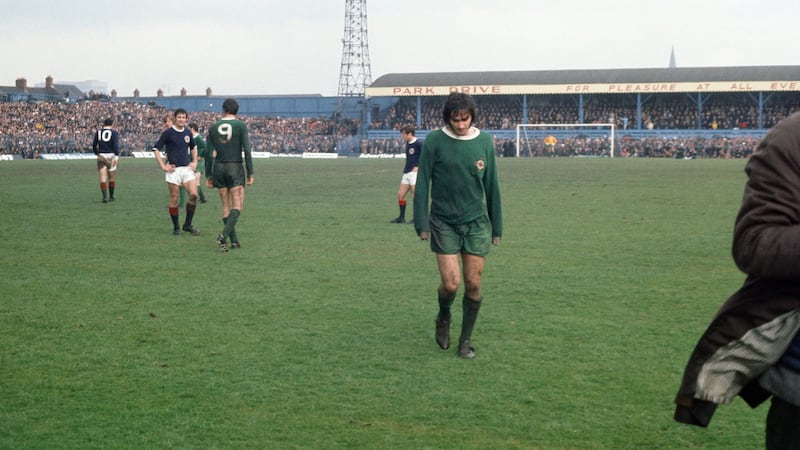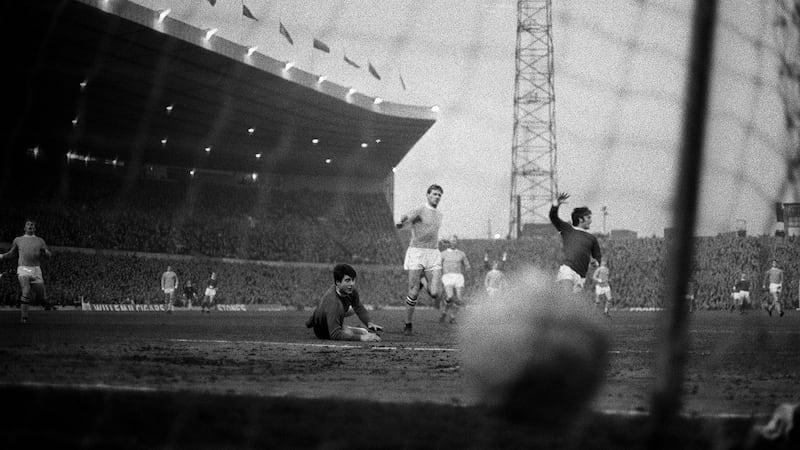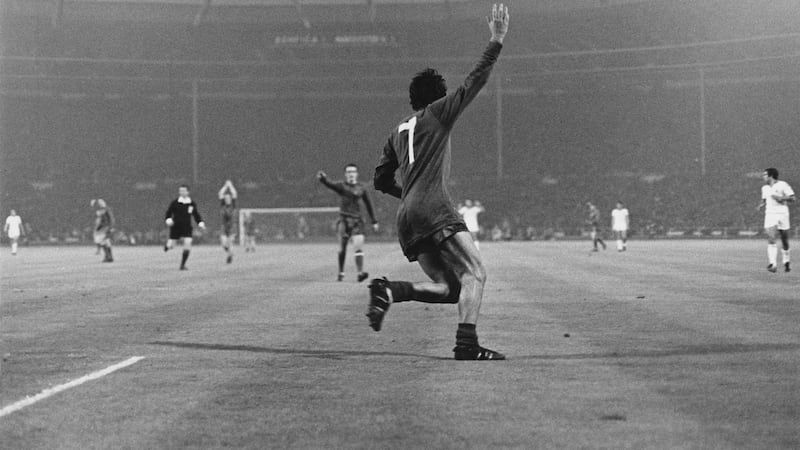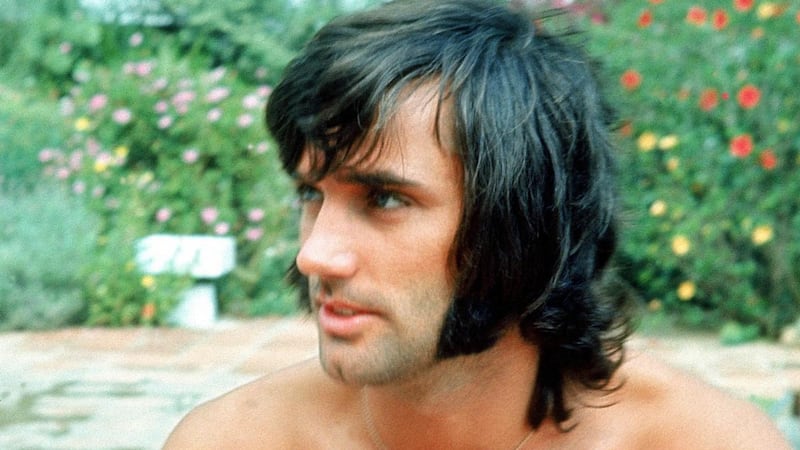Some 16 years on from his death on November 25th 2005, a simple black headstone still marks his grave. The last piece of commentary on how George Best lived his life comes without the E-Type glamour he brought to football.
For much of his living life, Best seemed somehow to exist as an ethereal presence, who appeared and then disappeared, who arrived and departed, who grew to hate the public glare and was rarely out of it.
When he was visible he gave bewitching agency to the underpowered post-1968 European Cup winning Manchester United side. Never less than a shimmering presence around the heavy winter grounds of the north of England, Best played a game nobody else could and lived a life few others would.
In Belfast, now, his ghost is everywhere. From the plain family grave to his terraced house on the Cregagh estate and the murals around the streets and motorway underpasses, Best's death as much as his life was a kind of wonder and envy, never less than loved, always Belfast's boy.
Cregagh is staunchly loyalist turf. But without knowing it, Best was a healer, his energy not noticeably orange or green in a city poisoned by such distinctions.
For his outings with Northern Ireland, fans from nationalist West Belfast would flood into the hostile 'Village' streets around Windsor Park just to see him.

"It was never anybody's thought. It never came across. You never for a minute stopped to think 'I wonder if he's a Catholic or a Protestant," says Jimmy Nicholl, who arrived at Tommy Doherty's Manchester United in 1974, the year Best left. The two subsequently played on the Northern Ireland team together, where Nicholl is now assistant coach.
“When you were lucky enough to have been in his company you could tell George was idolised by both sides.”
Best was a catalyst for change in how footballers played, how they looked. A poster boy for the liberated ’60s as much as Mick Jagger, or Twiggy, he swung through the grim flat cap, post war ’50s and onto an Old Trafford stage as the sexiest face in the sexiest club in world football. In that he never let them down.
He brought Carnaby Street to the pitch like a blinding flash of cravat to the backdrop of dimly lit Manchester and in the ’60s and early ’70s Belfast’s dystopian monochrome. Throughout, he was the man who couldn’t grow old, who found himself forever paused in a lifestyle that consumed him.
Lingering frustration
There is a morality tale somewhere and from the people who knew him a lingering frustration that as Best walked along the precipice of his life, the most exciting footballer in the game never saw a World Cup finals or even, beyond the European Cup in 1968, an extended run in European football.
"The one real regret I have for him is he never managed to get in the '82 World Cup. I think Billy Bingham did look at him," says the former Northern Ireland goalkeeper Pat Jennings.
“In matches he would come back to me - ‘Pat give me the ball, give it to me.’ So I would give him the ball just outside the box and he would run at whoever was trying to kick him.”

But in the muck of Goodison Park, Anfield or Maine Road, he was a precious stone even among revered Manchester United figures, Denis Law and Bobby Charlton.
As an atheist to conformity, Best’s otherness, especially in later years, often offended the senior players. But when he was in football mode they knew his value, his bang for buck and the 10,000 he put on gates. They also knew the brutality he suffered weekly at the hands of opposition in a permissive era of thuggery.
The word they used was brave. Brave.
“It was all about balance and how he used to ride tackles,” says Nicholl. “They would scythe him in two and he would ride the tackle. That was a skill in itself. When he was getting hacked he managed to keep his feet. Everything I learned about him was from the physios at Manchester United.
“The word they used was brave. Brave. He would come in on a Monday morning and the back of his calves, where players were running the studs down the back of his legs, they said his calves were in bits.”
Most of all, what the senior players knew was that the non-conformist troubled the opposition more often and more readily than he did sensibilities at Manchester United.
For almost half the time he was there, 11 years, Best was the club’s top goal scorer (five times), winning two league titles and scoring in their win over Benfica in the 1968 European Cup final.
“We both started on the national team on the same night in 1964 against Wales. We were both finding our way,” says Jennings. Just a year older and not yet with Spurs, where he would become one of their iconic goalkeepers, he remembers a callow teenager, polite and shy. Two kids on a journey together, Jennings from Newry and Best from Belfast.

“We were both making our debut, so they put us in the same room. I mean, him playing for Manchester United at 17 . . .
“He did everything but it was quicker than everybody else. His control was quicker. He took off quicker and had speed. He was that yard quicker than everyone else. That was against international players.
He must have nutmegged Neeskens five or six times.
"When George came back from America to Fulham (1976), the press was wondering whether he was going to be good enough at international level. We played the great Dutch team of Johan Neeskens, the Van de Kerkhofs, Johan Cruyff, all that lot in Rotterdam.
“George ran riot. Neeskens was doing a man to man marking job on him. He must have nutmegged Neeskens five or six times. Neeskens was trying to kick him out of it.”
Nicholl remembers it as Cruyff. It doesn’t matter, Neeskins, Cruyff, both, either. Best had arrived in Manchester United in 1963 at 15-years-old. Five years later, along with the European Cup, he would win the European Footballer of the Year, a trophy that in the early 1970s was won in successive seasons by Gert Muller, Cruyff and Franz Beckenbauer.
The point of difference was how Best played and looked as much as how effective he was. He arrived in a tie with a short back and sides and left a decade later in cheesecloth open to his navel and a Marbella tan.
He was a living weathervane, his clothes, his skin, his hair changing by the year with the cultural revolution that was taking place, his jinking dribbles and staccato runs of beating players once and sometimes, needlessly, twice part of the extravagant, expressive mood of the day. The zeitgeist, Best was it. Alone he brought it to football and football was queasy about it.
In 1969 Michael Parkinson made a documentary about him as a 22-year-old. Just as dazzling off the pitch, he candidly told him that he earned two or three times more outside football than he did from playing.
He’d hand 10 pound notes to beggars, €150 in today’s money. He didn’t think too much about it. He spent cash fast, he said. He couldn’t keep still, he said, had to be on the move “all the time.”
Impossibly good looking and vulnerable but already hardening towards a mind of his own, he was far from a braggart. But nor were there signs of false modesty. The fan mail was by the hundreds every week, mostly girls. Best wasn’t squeamish. He liked it, he told Parkinson.

“I left the club the year before George arrived with another chap from Belfast, Eric McMordie,” says Eamon Dunphy. “They only lasted two weeks. They ran away back home. Busby sent his scout and they persuaded George to come back.
“Eric McMordie would become a very good championship player for Middlesbrough. I was playing at that level as well so I played many games against him. Anyway they were very homesick the first two weeks and just decided to run off.
“There was a well known trajectory, youth team, reserve team, first team. Well, George skipped the reserve team. Busby just saw him and took a chance and played him in a very tough game one day, I think against West Brom, who had a killer left back.
When George was on his day nobody could play against him.
“He was sensational. Everyone knew he had the gifts and they were unusual gifts. Balance, yeah. He was tough. I mean if you’d met the two of us in our street clothes you’d think there was nothing much.
“Brilliant balance, a lot like Cruyff, Maradona, Messi. They were the same quality. Guys would try to kick them and it just wouldn’t work. George had that. He was very agile and very, very wiry and strong. Actually strong. He didn’t look it but he was. That was an exceptional factor in his game.
“When George was on his day nobody could play against him. There are these players, Messi springs to mind in our contemporary game, Cruyff in the past. When these guys were on they were sensational. They were unstoppable.”
Best was intelligent, says Jennings. He was complex too, says Dunphy, “lonely, shy, much smarter than most of the people around him.”
At 11-years-old he won a scholarship to a grammar school in Belfast, Grosvenor High. The school played rugby, so he skipped class to kick around a football. They withdrew the scholarship. A lesson learned. Stubbornly doing what he wanted could pay off.
Hollywood lead
That he was bright gave him no access to answers. Post European Cup win, he was a box office Hollywood lead, a Brando stuck in weekly episodes of B-movie productions. Manchester United were in decline and even with the return of Matt Busby for the 1970-71 season, the script was lame.
The club had won the league in 1963-64 and 66-67, won the European Cup in 1968 and came 11th in the league in 1969. It was around that time his face in the tabloids flagged another dumpster fire as he was fined by the FA for misconduct and grounded for missing a train for a match in Chelsea’s Stamford Bridge.
Four seasons later Manchester United flatlined and fell into Division Two.
“Every time George played, people were looking for him to do special things,” says Jennings. “He said to me that if he didn’t go past two or three players and score a goal, how disappointed people would be.”

“That was the sort of pressure George was under every week, every game he played, trying to impress every week and he didn’t have the team to back him up. Look at where they went from European champions to the second division.
“Had they been a team pushing in Europe every year, which they should have been, he would have been part of it. I’m sure he would have towed the line, wouldn’t have taken the route he did. That was him trying to build a reputation week in week out. Everybody in football was looking at him. The great George Best.”
Although his final retirement came at 38-years-old playing with the Brisbane Lions, by the time Best realised his art was not a panacea for everything at Old Trafford, it was too late.
The club had gone to the dogs and everyone was looking at George to save it.
It’s difficult to pinpoint exactly when the slide began, probably the first missed training session, but he was young when he began playing to the gallery.
All of his quips are threadbare now but one attributed to him as a player was revealing. “In 1969 I gave up booze and women, it was the worst 20 minutes of my life,” he said. He was 23.
Leaving Manchester United in 1974 was the clean break. Still capable of playing a vivid game with expression, the dare aspect, the gambler’s throw to nutmeg a defender, slalom past tackles, were still available but increasingly not always.
“He was the loveliest bloke. I literally never saw him with a drink problem,” says Jennings.
Dunphy as a player lived in digs “three doors or four doors or five doors” down from Best. As young professionals, they were pals for several years and used to go off in the evenings to play snooker together.
“He was extremely shy all his life. But he found ways usually with a few drinks to loosen up,” says Dunphy.
“The club had gone to the dogs and everyone was looking at George to save it. But there were senior players like Bobby Charlton and Denis Law who didn’t really have a lot of time for George because of his lifestyle. He wasn’t taken seriously by them.
“That was a kind of spiral. That’s when he started disappearing for days. He’d be tabloid fodder, which was really, really sad and tragic but inevitable.”
Best was no champion of death. To think that is to believe the false assumption that he had a say in choosing alcoholism. He died at 59-years-old in 2005 in Cromwell Hospital in London’s South Kensington, not far from Chelsea where in the ’60s he gilded the Kings Road as brightly as Old Trafford.
Diego Maradona died on the same date 15 years later, November 25th 2020.

The News of The World tabloid, on Best’s request, published a picture of him in hospital with Jaundice beside the caption “Don’t die like me.” Until that point there had been virtually no contrition.
“He was in Dublin, maybe the night we did the Late Late Show for the Busby book (1991),” says Dunphy. “I used to take a spliff now and again rather than get too much booze in me. George was a full blown alcoholic. He was drinking, just the two of us went outside for my spliff.
“I said to him ‘look George why wouldn’t you take a joint instead of fucking killing yourself with that shit. You don’t want to be drinking that mate.’ He looks at me. ‘No fuckin’ way am I ever going to take drugs.’
I'm not saying the tabloid cartoon didn't exist in some form, it did. But it wasn't George.
“I said ‘fucking hell George you’ve been pouring that shit into you for the last 15 years.’ That was his attitude. No way am I ever going to touch drugs. And he meant it. He was conventional in that regard when everybody was taking a joint.
“He was horrified. I mean spliffs in the working class culture of Belfast where George came from . . . That wouldn’t have been acceptable at all back in the day.
“George was a compulsive gambler. In some respects that was probably as bad as the drink,” he adds. “I think everybody knew he was running out of time. I was very, very thankful for the people who knew him and knew the real person as opposed to the tabloid cartoon. I’m not saying the tabloid cartoon didn’t exist in some form, it did. But it wasn’t George.”
The people of the city he came from still protect him. His family grave in Roselawn Cemetery seems deliberately and peacefully ordinary. But it is a shrine.
Fallible, flawed, troublesome, Best was like Belfast always has been, ill at ease with itself and the world and unable to do anything about it.
“There were only three or four E-Type Jags in Britain then and Best had one of them,” says Nicholl, capturing an enduring image. It’s the one people prefer, wistful and extravagant.



















